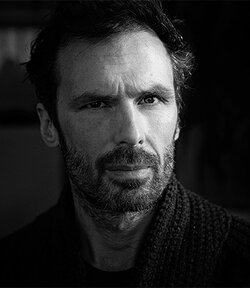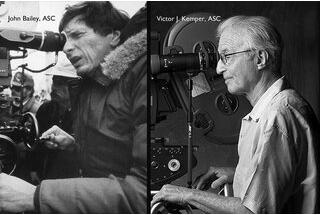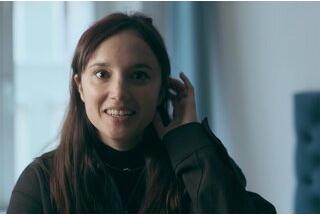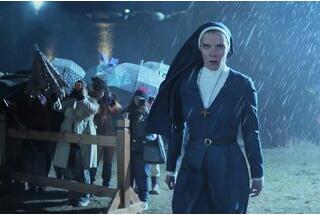Filming vertigo. Two experiences of shooting in a vertical environment.
By Stephan Massis, AFCWatching Sur le Fil
How can you portray emptiness? Vertigo? How can you bring our cameras into a vertical landscape and create cinema in a place where the images are usually taken by mountaineers or documentarists? Is it possible to shoot on a cliff with relatively simple technical means at one’s disposal in a way that is financially affordable?
I wanted to tell a little story that would enable me to test out a method for filming scenes on a cliff with the language of a fiction film, using only rope techniques used in mountaineering, and relying on postproduction to combine the footage from the wide-angle sensor cameras and the drone.
With a script and a storyboard in my pocket, I put together a little crew of my friends and we went to Pen Hir, in Brittany, in early July 2019.

The crewmembers were Axelle Zavatta and Julien Frison, the two climber-actors, Alan Graignic, drone pilot, Jean-Michel Poulichot, camera assistant and second camera operator, Marie Guédon, data expert, and myself.
Thanks to the support of RVZ, Frames Dealer, and Sigma, we were able to have two cameras: a RED Monstro and a Helium, a series of SigmaCineLens lenses for the 8K, two Sigma 16-35 and 50-100 mm zoom lenses for the S35, and an Inspire DJI drone.
Location Scouting
The cliff of Pen Hir was ideal from a logistical standpoint. It was possible to access the routes from above and there was a parking lot at the top of the cliff. However, the exposure to sunlight wasn’t ideal. The cliff faced west, and so the sun only fell on our location around 11 am. We’d planned 3 days of shooting, and so we had to do our best to optimize the camera placement in relation to the sun, since the story I wanted to tell takes place in one day. We knew that we wouldn’t be able to avoid shooting at times where the sun would be too frontal or too zenithal, and I was counting on the colorist to be able to reinject volume into those images, which were going to lack depth and contour.
Shooting
Julien was going to climb up a route near another line outfitted with “bolts” (pitons permanently sealed into the rockface), and there I could set up fixed ropes that would protect me during shooting. Because this was a self-produced project, I didn’t have any mountain guide grips, so I had to install those lifelines myself and that operation consumed a lot of my physical and mental energy. I noted in my journal: “Never again without grips!” We shot using two cameras. Jean-Michel Poulichot behind the Helium and the zooms, and me behind the Monstro and the fixed lenses.
I had a saddle harness that allowed me to remain suspended for long periods of time, and the camera was configured as simply as possible, on a sling. A bag containing a lens, filters, a battery and a spare memory card was attached to my harness.
Depending on the angle of the sunlight, I would choose one of the static ropes that I had installed earlier on, and that would be the axis I would work from for the next hour. I could move myself up and down, descending with the rappel or ascending with the ascender. Moving horizontally was more challenging, but it depended on the equipment in place. Most of the shots in the film were taken that way, suspended in the air.

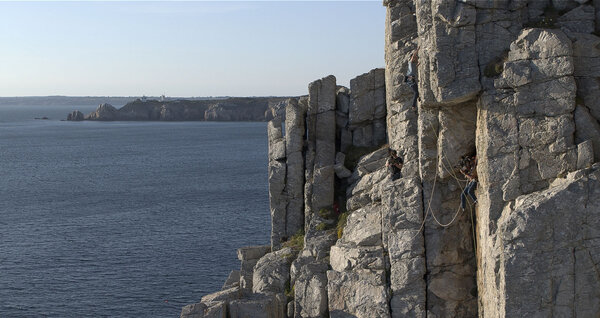
If necessary, we would double or triple our takes. Of course, to save time, we took maximum advantage of each camera position before we moved. Once we were satisfied with what we’d recorded with the two cameras, we would clear the field in order to shoot the drone shots.
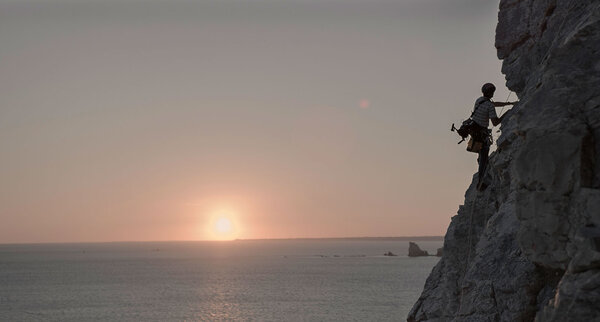
Postproduction
Amazing Digital Studios were involved from the start of this experiment.
Knowing that the west-facing exposure of our cliff would be a problem, I was counting on my colorist as an essential partner. I also wanted to find out what the true possibilities of mixing images from an Inspire drone with the 8K images from the Red Monstro and the Helium. Fred Savoir developed fantastic tools for stabilizing and fluidifying the drone images. Similarly, he worked on the DJI and RED curves, and succeeded in making the images from these different cameras match perfectly. (See Color Breakdown).
Sur le fil
Featuring Axelle Zavatta and Julien Frison
Script by Sylvain Tesson
Directed by Stephan Massis
Cinematography: Stephan Massis, AFC, Jean-Michel Poulichot
Drone: Alain Graignic, Tiltop Films
Data: Marie Guedon
Music: Côme Aguiar
Editing: Vianney Meurville
Camera Equipment: RVZ (RED Monstro, RED Helium, Sigma CineLens series, Sigma 16-35 mm and 50-100 mm zoom)
DJI Drone: Mavic
Sound post-production: Thomas Thymen, David Trescos
Colorist: Fred Savoir, Amazing Digital Studios
I wanted shooting Sur le fil to be simple and affordable from a technical standpoint. This was related to the financial realities of a self-produced short film, but also a credo that I wanted to test out.
On the shoot of the advertisement for "Schmidt Vertical Home", directed by Neels Castillon and produced by Quad, the project required much more substantial means.
Schmidt manufactures custom kitchens. The company wanted to advertise that it is capable of fulfilling all of its clients’ desires, even the craziest ones, such as installing a kitchen and a wardrobe on the side of a mountain, in the middle of a wall of rock.
The advertisement was only to last 20 seconds, but everything had to be “real”, it was out of the question to use green screens or special effects.
A “web documentary/making of”, which was to be an integral part of the advertising campaign, would recount each step of this adventure (especially episodes 1, 3, 5, and 7)
Neels Castillon contacted me with this double desire: to shoot the eight episodes of the web documentary and the 20-second-long advertisement.
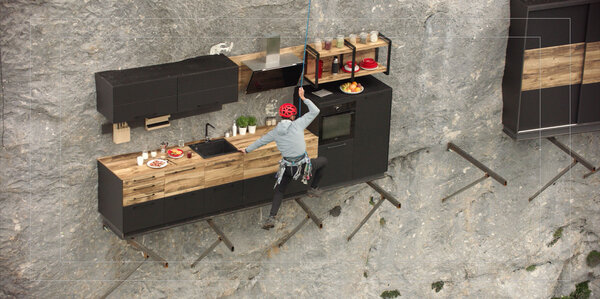
For this particular shoot, I put together a team of veteran technicians who also had mountaineering abilities. They also had to be good teammates, capable of withstanding life during a two-week-long expedition, as we were to be housed in mountain refuges or in tents.
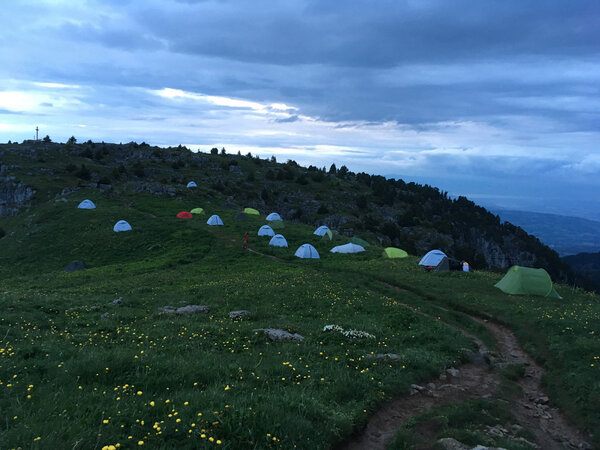
Location Scouting
The ideal cliff had to be well-exposed, high in altitude but still accessible, and provide both safety and adventure… For the lighting, I wanted the cliff to be exposed south-east, which would provide both vertiginous perspectives and allow the sun to be in the field in the morning. We also wanted a nice, flat slab of stone that was big enough to house the set, which was 9 meters long.
The cliff had to be accessible from above, with a relatively flat area at its peak, where we could work. It was absolutely necessary to find a space to set up a base camp not far from the set, where the thirty-odd crewmembers would be housed. Lastly, we had to find a location where the producers would be able to get official permission to shoot without too much difficulty, even though this is a highly protected region.
Our first choice was on the cliff of the Aguille de Varan, in Haute-Savoie. This was a magnificent location, which was visually exactly what we were looking for, but required a great deal of safety preparation in advance. This work ended up being much more complicated than what we were hoping for, and so we had to give up that location, which we’d found so enchanting, and where we’d already begun working.
Our plan B was the cliff of Parmelan, above Annecy, which was more “production friendly”. The peak was less high, access was easier. There was a nearby refuge that could host a part of the crew at night. An old cable car used for supplying the refuge would be a great help to us for bringing up our equipment. The face was indeed facing south, but to the east, other cliffs hid the sun for most of the morning. The perspectives were less impressive and less “high mountain” than what had been written in the script. Nonetheless, it was a very beautiful location, very steep, and we quickly got over our first choice.
Preparation
The 20-second advertisement was storyboarded and approved by the client, the agency, and the producers. Therefore, we had to respect each shot and painstakingly shoot exactly what was written. Neels Castillon wanted a living camera, carried on the shoulder, close to the actors. The “board” shots required me to be at least 5 meters away from the rock face. I had to be able to move from one position to another fairly rapidly in order to be able to take best advantage of the natural light.
My (relative) comfort was also important. Of course, we’d foreseen that the clients, who were set up in a tent near the refuge, would sometimes need to discuss the shot and I would have to wait during those conversations.
Vincent Blasco, key grip and rope access technician, and I, came up with a system that met all of those needs: speed of execution, comfort and security. Vincent ably responded to a sketch I made on a paper tablecloth between dessert and coffee during our first meeting and built a hanging chair, moving on a 13-meter by 7-meter frame, which was hung about a dozen meters above the set. A system of ropes that could be moved on winches enabled the chair to be moved along three axes.
I would be the only one who would be offset from the cliff, so Vincent came up with a system enabling me to make changes to the camera without the risk of dropping a lens (the precious and magnificent Zeiss Supreme Primes that we were amongst the first to use) or a battery…
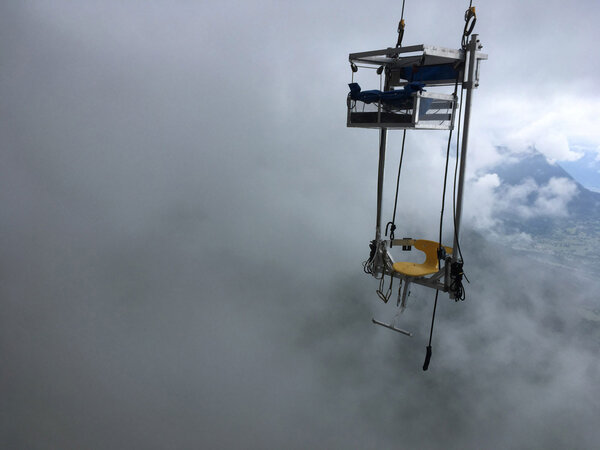
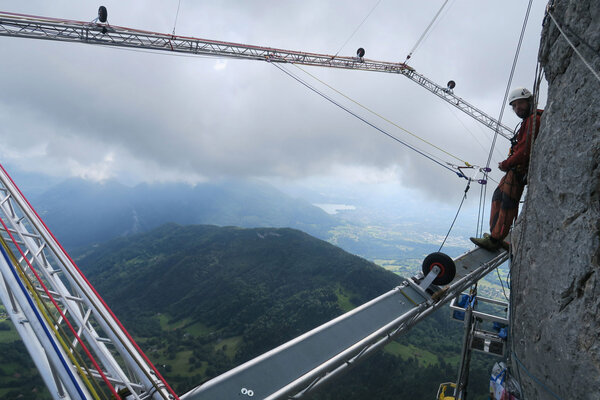
Jean-Michel Poulichot, the camera assistant, would be positioned on the frame in order to control the focus using a motor. Our complex grip set-up was also part of the brand’s communication strategy and Guy Péchard, our production director, approved and supported this option.

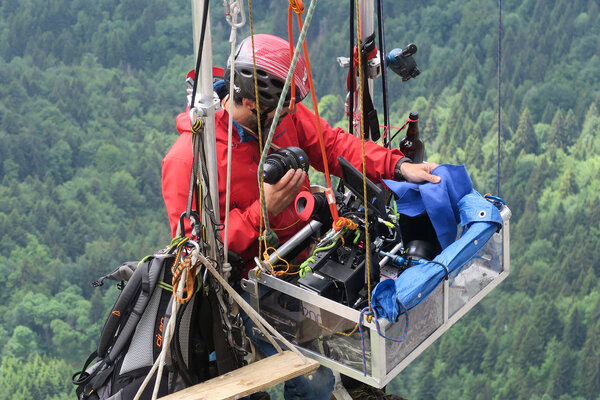
Shooting
The shooting script called for two days to shoot the eleven shots from the script.
The story we were telling took place in the morning. Ideally, we had to have a low and strong sun, but we knew that it would be hard to keep that match consistent throughout all of our shots. The weather changes quickly on a mountain, and over the course of two days, we were certainly going to shoot in different lighting conditions.
In order to enable the editors to create a coherent “light” narration and not to return home without having recorded all of the shots, we invented a method.
There were two reference shots that provided the ambience for the film, and in these shots the time of day was crucial because of the angle of the sun. We had to be lucky for those two shots, because the others could handle a possible wrong color or less favorable sun positions.
For security reasons, we’d taken care of the storyboard by shooting each shot as soon as it was possible to do so. We would even shoot when the lighting wasn’t ideal because we wanted to store shots away in case the weather deteriorated.
However, we kept the possibility of shooting some shots over again if the light became better, more exact, or if things just hadn’t gone as we’d hoped the first time around.
In order to make sure we shot in good lighting, we knew we’d have to be very agile and flexible, capable of changing our equipment rapidly and to be prepared to deal with the capricious weather: on a mountain, the unpredictable is predictable.
Shooting was planned for 5-6 June 2018. The weather was catastrophic that spring, and furious storms unleashed themselves on us almost every day during preparation, forcing us to interrupt our work. Nobody on the crew thought we would be ready on time, but we had an obligation to provide results.
Our set design (Jérôme Krovicki, Barthelemy Robino), grip, and stunt (Vincent Blasco, Arthur Erhet, Remi Canaple) crews were expertly seconded by our guides and the Ydems acrobatic construction teams (Yannick Demizieux) didn’t limit the number of hours they worked or their efforts to make sure we were ready on time. Or nearly…
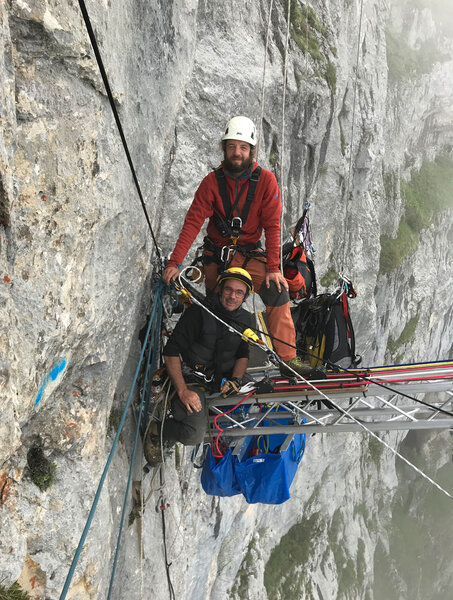
The first day of shooting, the kitchen was set up, the frame and my chair installed, but we hadn’t yet had the time to test the chair’s mechanism and the set designers still had a bit of work to do. Yet, we had to begin shooting, so we did… The first shot was supposed to be a long, very rapid backwards traveling shot from a helicopter, but that morning the weather was bad and the set was disappearing behind thick fog.
We’d hoped for a break in the weather, but in vain. The sun didn’t show its face that day or the next day. And moreover, big storms came overhead in the afternoon, which forced us to stop shooting and flee the location.
Happily, both of those days were covered by our insurance.
While a part of the crew went back down into the valley for some well-deserved rest, the set designers and the grips took advantage of the delay to finalize what they hadn’t yet been able to finish. When, a few days later, the weather had finally improved and we were totally ready, shooting wasn’t much more than a formality.
Of course, it’s pretty rare for screenplays to contain scenes that take place in a vertical environment, especially in fiction films. What a pleasure it was, though, to be able to combine my passion for mountaineering with my profession of cinematographer.
On a mountain, as on any other location, but perhaps a mountain involves more issues, our responsibility as DoP is to offer technical solutions that take both the reality of the terrain and the production requirements into account in order to provide the best possible image, an image that makes sense and that fulfills the director’s expectations and ambitions.
Every time, we’re making a wager, because a beautiful location is never easy to film. It is difficult to approach projects like that with our normal reflexes and habits from urban sets. It’s up to us to find the right methods for these unusual projects.
In order to film vertical nature, the temptation is great, and I wasn’t able to resist it, to fall back on solutions that raise ecological questions that we can no longer avoid asking ourselves.
That’s also why I tried the experiment of Sur le fil: how to narrate nature, the mountain and vertigo in images, using means that I hope were more ethical than what we might have done in the past.

Director: Neels Castillon
Cast: Kenton Cool
Agency: Full Six
Production: Quad
Production Director: Guy Péchard
DoP: Stephan Massis, AFC
Second camera operator: Thibaut Koralewski
1st Assistant Camera: Jean-Michel Poulichot
2nd Assistant Camera: Pierre Addoun
Data & Editing: Sébastien Rouquet
Grip: Vincent Blasco, Arthur Erhet
Stunts: Rémi Canaple
Acrobatic Construction: YDEMS, Yannick Demizieux
Electricity: Frederik Vanard
Colorist: Arthur Pau
Camera Equipment: (RVZ, RED Monstro, and Zeiss Supreme Primes)
Drones: Mavic (2 pro DJI and Inspire DJI)
Helicopter Camera: Cineflex Ultra (RED Helium, Canon 30-300 mm zoom).
 En
En
 Fr
Fr